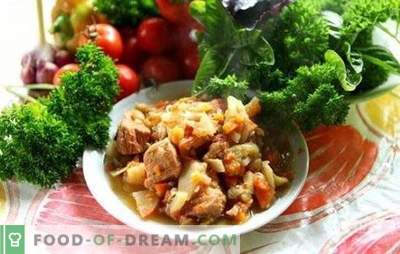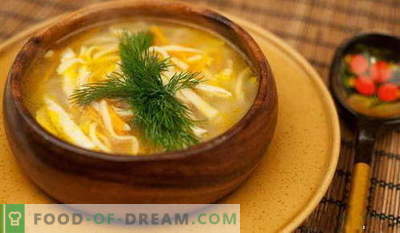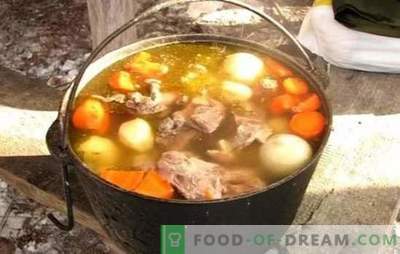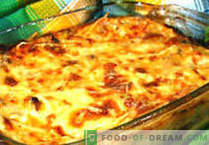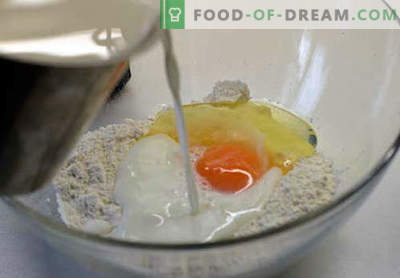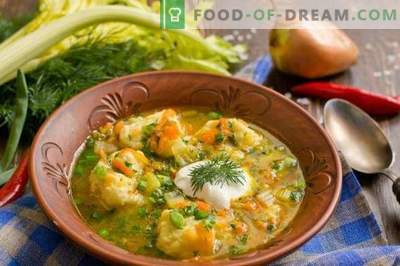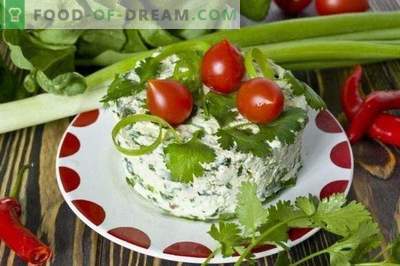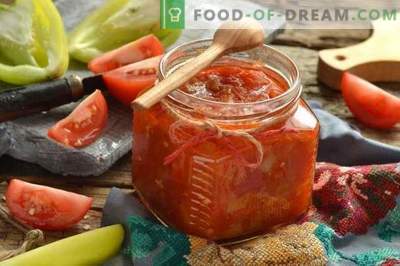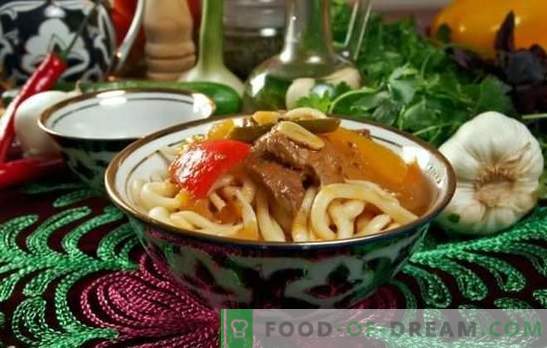
Soft, juicy meat with vegetables in a fragrant sauce, tasty noodles, spices, spices and greens are all Uzbek lagman - a dish that is worth the effort spent on its preparation.
Laghman in Uzbek - general principles
The composition of the dish includes noodles, meat and vegetables. By choosing all the ingredients fit with great care and even with love - this is a guarantee of the result: taste, appetizing appearance and satiety.
Meat. Mostly take lamb, but it can be safely replaced with veal, chicken. The meat is cut into slices of medium size, fried, then boiled with spices and vegetables. Of the spices, they mainly use cumin, pepper, adjika, hops-suneli.
Vegetables. There are no restrictions here: tomatoes, sweet and hot peppers, cabbage, radish, beans, carrots, onions and others. It is important that all vegetables are fresh, free from rot and signs of spoilage. Vegetables are cut, rubbed, chopped and spread to the meat, braised until cooked.
Noodles. You can purchase the finished product, but it is tastier and more interesting if homemade noodles. Water, flour, egg and salt are all you need. Knead the dough tight, give it a rest, then roll out, cut, twist, pull. Masters of the business achieve that the lagman's noodles reach at them in length to five meters.
They serve lagman in a special way: spread noodles on a deep plate, put meat and vegetables on top, pour all with gravy in the desired quantity, sprinkle with fragrant fresh greens.
1. Laghman in Uzbek
Ingredients:
For noodles:
• 250 ml of oil;
• 4 eggs;
• flour - 800 g;
• half a teaspoon of salt.
For waji:
• a small piece of lamb;
• onions - 4 pcs .;
• 1 green radish;
• 0.5 kilograms of tomatoes;
• garlic head floor; • 3 carrots;
• bunch of dzhusay;
• hot pepper - a couple of pods;
• 6 bell peppers;
• green beans - 6 sticks;
• salt, seasoning - 20 g each;
• fresh celery - 3 stalks.
Preparation:
1. Knead dough for noodles: break an egg into a cup, add salt, flour, pour in oil and stir well. When the dough becomes tight, lay it on the table and press it with our hands. Cover the dough with foil and leave for a couple of hours.
2. Cut the dough into pieces, roll the rope out of each one. All the resulting flagella leave for half an hour, so that they become more elastic.
3. After the allotted time, the strings are again rolled out, increasing in length, and cut into small pieces of 3 cm. We grease them with oil and roll them into long flagella. Grease again with oil and leave for half an hour under a towel. And so we do it several times.
4. We take the harnesses rolled out several times at one end and begin to twist in a circle, often hitting the table with them in order to provide them with plasticity.
5. Boil the cooked stretched noodles in lightly salted water for 5 minutes, rinse in a colander.
6. Cooking the waja: chop the onion into rings, carrot, radish - medium cube, Bulgarian pepper - straws, tomatoes without the skin - dice, dzhusay and green beans - 3 cm thick slices, garlic - plates, 1 hot pepper cut into strips.
7. Mutton pulp cut into thin strips.
8. Put lamb seeds in a frying pan with hot oil, fry until crispy crust.
9. To the bones, lay out the flesh and fry until complete evaporation of the juice and release of fat.
10. Lay onion and fry until light brown onions.
11. Add the carrot, beans, radish, fry until dark carrots.
12. Put the hot pepper, chopped celery stalks and tomatoes, season with spices, salt, and fry over high heat for about five minutes.
13. When the juice from the tomatoes boil, put the Bulgarian pepper, fry, stirring, a couple of minutes. 14. Pour water to full coverage of all products, bring to a boil.
15. We regulate the fire to the smallest and we torment a little, if necessary, we add some salt, put the dzhusay, mix, boil for several minutes.
16. When serving, put the noodles in a plate, pour in a small amount of broth after cooking, spread vaja on top, sprinkle with finely chopped parsley leaves.
2. Uzbek lagman with cabbage and radish
Ingredients:
• Mutton tenderloin - 600 g;
• 1 eggplant;
• 2 medium tomatoes;
• a small piece of cabbage;
• 2 carrots;
• onions - 1 pc .;
• 100 ml cooking oil;
• 4 sweet peppers;
• 3 potatoes;
• 1 green radish;
• garlic - 4 cloves;
• seasoning, salt - 30 g each;
• dill, fresh cilantro, parsley - 3 stalks;
• noodles - 200 g;
• some olive oil.
Preparation:
1. In a container with a thick bottom, pour the oil, heat, lay out the finely chopped garlic, fry until golden brown and remove the garlic with a slotted spoon.
2. Put the diced meat into butter, fry until crisp.
3. Add chopped onion, mix and fry a little.
4. Add eggplant, cabbage, carrot, pepper, radish - all in strips, fry until tender.
5. Add crushed tomatoes without skin.
6. Separately cook the noodles, recline in a colander and oil it with olive oil.
7. In the vaja, we make the potatoes in a cube, add a little salt, pepper, season with seasoning, pour in water so that all products are completely closed.
8. After boiling water boil for 30 minutes.
9. When serving at the bottom of a serving plate, pour in some greens, chopped garlic, put noodles on top, then sauce with vegetables and meat.
3. Spicy Lagman in Uzbek with beef
Ingredients:
• a small piece of beef tenderloin;
• long noodles for lagman - 350 g;
• a piece of cabbage;
• 2 stalks of stalked celery; • 1 tomato;
• 1 onion;
• a couple of carrots;
• 1 pod of bitter pepper;
• 1 Bulgarian pepper;
• green radish - 1 pc .;
• garlic head floor;
• adjika, coriander, paprika all powdered, salt - pinch;
• 5 Art. spoons of oil for frying.
Preparation:
1. Put beef tenderloin cut into thin strips in the pot, fry, add meat, rudiness, salt.
2. Add onion - straws, carrot - dice, fry for a few minutes, stirring.
3. Remove the skin from the tomato, chop the flesh, add to the container to the products.
4. We also lay sweet and hot peppers in the pot, fry for a few minutes.
5. Add the chives, skip through the press, add dry spices, add some salt.
6. Lastly, we lay the cabbage, celery and radish, chop them up in any shape, fry some more.
7. Pour in 6 glasses of water and cook until all the vegetables have melted.
8. Put boiled noodles in a colander, oil them with oil.
9. When serving in a soup dish, lay out the noodles, pour vegetable-meat sauce on top, sprinkle with parsley.
4. Uzbek hastily laghman
Ingredients:
• soy goulash - a plate floor;
• long noodles - 2 packs;
• 4 potatoes;
• a pair of bulbs;
• 1 carrot;
• tomato puree - 10 g;
• a pinch of salt and black pepper;
• leaf of laurel;
• 6 Art. spoons of cooking oil;
• garlic - the floor of the head;
• 5 dill stalks.
Preparation:
1. Put the noodles in boiling slightly salted water, cook for 3 minutes, put in a colander, oil with oil.
2. Put the soy goulash on the pan with heated oil, stirring, stir fry until crusty.
3. Cut the potatoes into medium cube and cook in lightly salted water until softened.
4. Fry the onion in a frying pan, cut into cubes, with carrot, chopped on a grater with large teeth.
5. To the vegetables put tomato puree, stir, warm slightly.
6. Add soy goulash to the pan, simmer on moderate heat for a few minutes. 7. When the potatoes are cooked, pour the broth into a separate pan and put the vegetables with goulash in it, boil a little.
8. For 1 minute, put chopped herbs and garlic.
9. Ready lagman laid out in portions, pour a little broth, sprinkle with herbs and garlic.
5. Laghman in Uzbek in a multicooker
Ingredients:
For homemade noodles:
• 10 glasses of flour;
• glass of water;
• 1 egg;
• salt - 5 g;
On the sauce:
• 1 kg of young veal;
• some cooking oil;
• 3 potato tubers;
• onion head;
• 3 cloves of garlic;
• sweet pepper - 1 pc .;
• a couple of small carrots;
• 1 green radish;
• 2 tomatoes;
• dill - 4 stalks;
• salt, any spice, black pepper powder - 30 g each.
Preparation:
1. Knead a stiff dough of all the necessary products for noodles, leave it for a couple of hours, wrapped in a plastic bag.
2. Divide into pieces, roll into cakes and cut into long thin strips.
3. Boil noodles in water, then mix with butter. Pour broth into another pot, it is still useful.
4. We cut the flesh of the veal into cubes, spread it into a multicooker container, set the “frying” mode and fry with oil for a few minutes, together with onion half rings and tomato slices.
5. After 10 minutes, put the radish, pepper, carrot - diced, chopped garlic and fry a little.
6. Pour water, put the potatoes in a cube, season with various spices, pepper, add some salt and cook until softened.
7. When serving in a batch dish, put the noodles, then the meat sauce, decorate with dill and parsley.
6. Uzbek lagman with spinach
Ingredients:
• beef - a little less than a kilogram;
• green beans - 3 pods;
• a little tomato paste;
• onions - 1 pc .;
• a pair of bell peppers;
• garlic - 6 cloves;
• 2 leaves of spinach;
• some oil;
• allspice powder, salt - 30 g; • noodles - 350 g
Preparation:
1. Pepper, onion, cut into cubes, garlic - chop with a knife.
2. Beef cut into thick strips, fry until brown, adding butter.
3. Pour in water and weary a little.
4. Once the liquid has evaporated, put onion, tomato paste, fry for 7 minutes.
5. Lay the sweet pepper, garlic, fry for a few minutes.
6. Put the beans, spinach, cut into small pieces, add some salt, pepper, add seasoning, stir, close the lid and simmer for 5 minutes. If the liquid evaporates, you can add water.
7. Boil noodles and mix with butter.
8. Spread a small layer of noodles on a batch dish, over the meat sauce, then again the noodles and sauce. Sprinkle with dill, sprinkle with acetic acid, sprinkle with a manhole (spicy Uzbek seasoning).
Uzbek Lagman - Tips and Tricks
• Greens: cilantro, dill, celery, green onion feathers, dzhusay, parsley will decorate and enhance the taste of the Uzbek lagman. You can sprinkle the finished dish with it or put it on a table on another plate so that everyone can take the amount they need.
• Uzbek Laghman will be tasty if meat and vegetables are stewed for as long as possible. It is important that the fire is minimal, that the wajja does not boil.
• Cook noodles no longer than the specified time, if it boils soft, it will negatively affect the taste of the finished dish.
• Serve the lagman hot, especially when it is freshly cooked.

